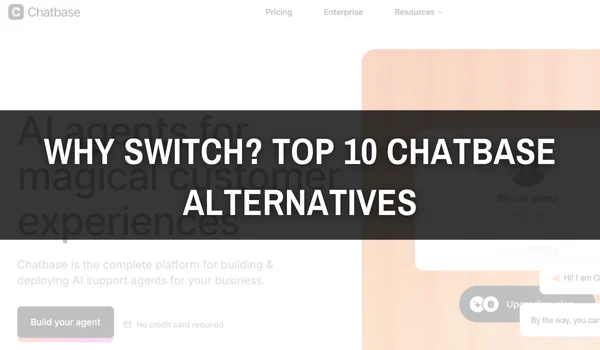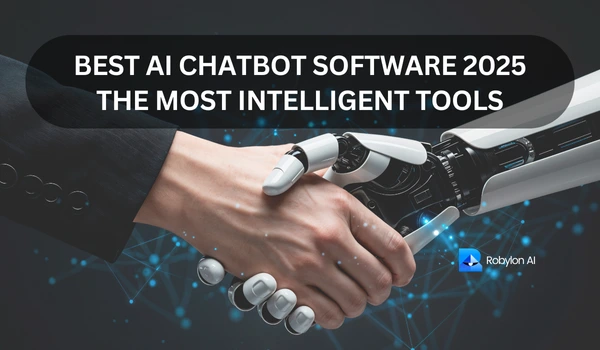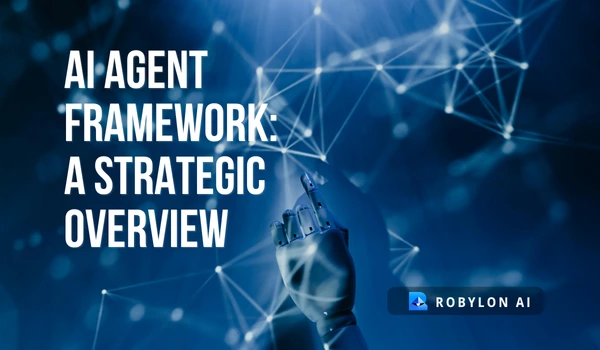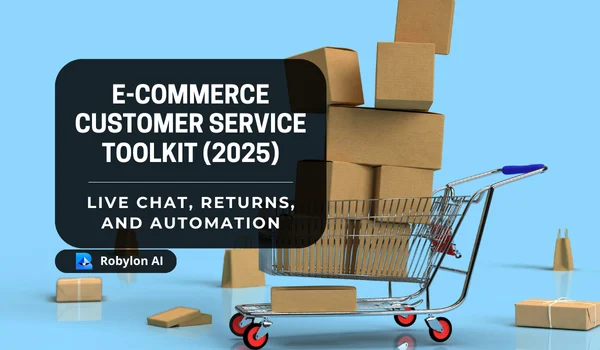Introduction
The chatbot market is growing fast. Businesses now rely on bots to scale support, engage users, and reduce costs. Two main types of chatbots include Rule-based chatbots that work with predefined scripts while AI chatbots use machine learning and natural language processing.
Both serve different goals. Choosing the right one can impact your customer experience, operational efficiency, and support accuracy. In this guide, you will learn how rule-based chatbots and AI chatbots differ covering - how each works, their key features, and which type fits your business needs best.
Whether you run a startup, e-commerce brand, or an enterprise team, this chatbot technology comparison will help you make the right decision. Curious how AI chatbots make life easier for teams and customers alike? Book a demo to know more.
What Is a Chatbot?
Chatbot is a program designed to simulate human conversation through text or voice. Businesses use chatbots to automate responses, guide users, and resolve queries without live agents.
Most chatbots fall into two types. Rule-based chatbots follow predefined scripts and logic trees. AI-powered chatbots use natural language processing and machine learning to understand input and provide dynamic responses.
A rule-based chatbot works like a decision tree. It matches user inputs to keywords or buttons and delivers fixed responses. These bots handle FAQs, order tracking, and simple workflows with ease.
AI chatbots are more flexible. They analyze language context, detect user intent, and improve over time. These bots adapt to different queries and deliver more natural interactions.
Both chatbot types help reduce support costs and improve customer experience. The right choice depends on your business goals, support volume, and required functionality.
What Is a Rule-Based Chatbot?
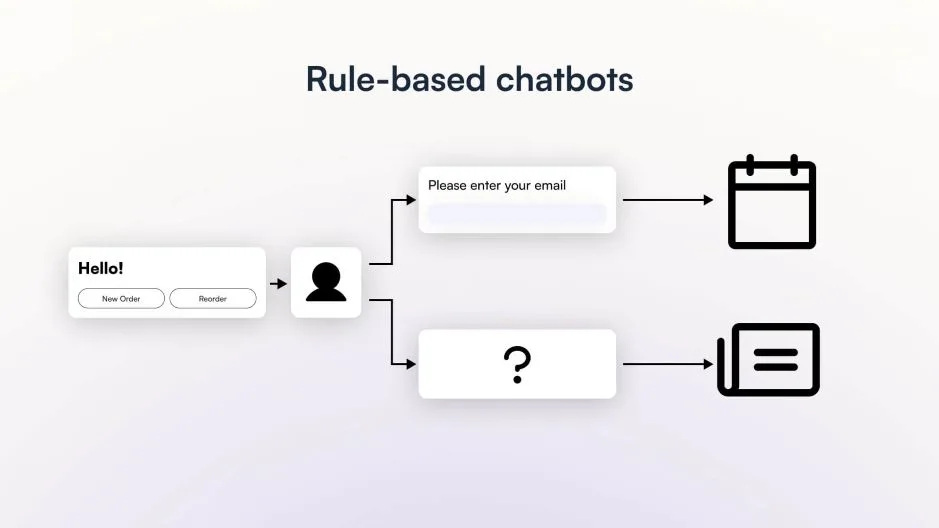
A rule-based chatbot is a conversational tool that responds based on predefined rules and flows. These bots operate using if-then logic, where each user input triggers a fixed response. The interaction follows a chatbot flow design, often built as a decision tree or menu structure.
These chatbots are commonly referred to as script-based, menu-based, or button-based systems. The responses are hard-coded during development, using pre-defined chatbot scripts to guide the conversation. Each question or choice leads the user along a path mapped in advance.
A rule-based chatbot does not understand language context. It doesn’t learn or adapt. It simply recognizes specific keywords or button selections and delivers programmed replies. This makes it ideal for handling simple, repetitive tasks like:
- Answering FAQs
- Booking appointments or tickets
- Providing shipping or return policies
- Collecting contact details through lead forms
These bots are popular in e-commerce, hospitality, and basic customer service. For example, a user asking about store hours might click a menu button, which prompts the bot to reply with a set time. If a user asks something outside the script, the bot will fail to respond meaningfully.
What Is an AI Chatbot?

An AI chatbot is a conversational agent powered by machine learning (ML), natural language processing (NLP), and conversational AI technologies. Unlike rule-based bots, it learns from past interactions, understands user intent, and adapts its responses over time.
These bots process inputs through contextual analysis. They can interpret user queries even when phrased in unfamiliar ways and generate dynamic replies that mimic human conversation. This makes AI chatbots well-suited for handling complex, multi-turn dialogues in real time.
AI chatbots are often called intelligent virtual assistants. Examples include ChatGPT-powered bots, support bots on e-commerce platforms, or in-app assistants that guide users through transactions or troubleshooting.
How Do AI Chatbots Work?
- NLP (Natural Language Processing): Enables the chatbot to understand grammar, semantics, and sentence structure to grasp the meaning behind user inputs.
- Machine Learning: Allows the bot to learn from conversations, improving accuracy and relevance over time.
- Context Management: Tracks conversation history to maintain coherence and continuity.
- Intent Recognition: Identifies what the user wants based on word patterns, tone, or prior messages.
- Entity Extraction: Pulls relevant data like product names, dates, or order IDs from messages.
Key Features of AI Chatbots
- Personalized Responses: Replies adapt based on user behavior, past chats, and preferences.
- Multi-language Support: Chatbots can interact in several languages, increasing global accessibility.
- Proactive Engagement: Bots can initiate conversations, make recommendations, and guide users.
- Integration-Ready: Easily connects to CRM systems, knowledge bases, or support tools.
Wondering why everyone’s talking about AI chatbots? Discover AI Chatbots: What They Are and Why They Matter in our detailed blog.
Rule-Based Chatbot vs AI Chatbot: Core Differences
When choosing between a rule-based chatbot and an AI chatbot, understanding their core differences is key. Each technology suits different business needs and user expectations.
A rule-based chatbot operates through pre-written chatbot flow designs, which use if-then logic and decision trees. These bots are great for predictable, structured queries like FAQs, order tracking, or form submissions. However, they lack the ability to understand natural language or provide context-aware responses. They also do not improve unless updated manually.
An AI chatbot, powered by machine learning, NLP, and conversational AI, goes a step further. It can handle dynamic conversations, understand intent and emotion, and learn from each interaction. These bots grow smarter with usage and are suitable for complex support scenarios, multilingual support, and personalized customer journeys.
While rule-based bots are affordable and quick to launch, AI chatbots are better equipped for long-term scalability, accuracy, and user satisfaction.
Pros and Cons of Rule-Based vs AI Chatbots
Here is a breakdown of the strengths and limitations of each approach:
Advantages of Rule-Based Chatbots
- Easy to Set Up: Requires no coding or data science expertise. You can launch it using predefined chatbot flow designs.
- Cost-Effective: Low development and maintenance costs make it ideal for small businesses.
- Predictable Behavior: Users always receive consistent responses due to pre-defined chatbot scripts.
- Fast Deployment: Go live within days using chatbot automation templates.
Limitations of Rule-Based Chatbots
- Limited Use Cases: Works only for FAQs, order tracking, and scripted flows.
- No Intent Understanding: Cannot detect user intent or context.
- Rigid Logic: Falls short when queries deviate from expected inputs.
- Poor Scalability: Maintenance becomes harder as scripts and decision trees grow.
- Rule-Based Chatbot Limitations: Cannot learn or improve over time.
Advantages of AI Chatbots
- Learns and Adapts: Uses machine learning and NLP to improve with every interaction.
- Handles Complex Queries: Understands intent, even from messy or ambiguous inputs.
- Personalized Responses: Adjusts replies based on past conversations and customer behavior.
- Multilingual Capabilities: Can support global audiences through language understanding.
- Scalable and Flexible: Easily handles large query volumes and varied topics.
- Chatbot Accuracy: Increases over time by learning from real interactions.
Limitations of AI Chatbots
- Higher Setup Time and Cost: Needs quality training data, NLP modeling, and testing.
- Ongoing Maintenance: Requires constant monitoring and updates to ensure chatbot accuracy.
- Misinterpretation Risk: May respond inaccurately without enough training.
- Complex Development: Involves deeper technical knowledge and integration steps.
Use Cases: When to Use What
Choosing between a rule-based chatbot and an AI-powered chatbot depends on the type of interactions, complexity of queries, and the user experience you aim to deliver. Below is a quick reference table and key use case insights.
AI-Powered Chatbot Use Cases
An AI chatbot is ideal for businesses that need contextual understanding, multilingual communication, and intelligent automation. Common examples include:
- Customer Support Chatbot: Handles diverse and unpredictable customer queries 24/7 with high chatbot accuracy.
- E-commerce Assistant: Recommend products, track orders, and recover abandoned carts using intent recognition.
- Healthcare Virtual Assistant: Manages appointment scheduling, symptom triaging, and patient FAQs.
- Financial Services Bot: Guide users through complex tasks like investment options or insurance claims with clarity and adaptability.
Explore how they boost sales, support, and engagement: Proven AI Chatbot Use Cases for Business in 2025
Rule-Based Chatbot Use Cases
A rule-based chatbot is best for narrow, repetitive tasks with minimal variation. These bots are fast to set up and easy to manage:
- FAQ Automation: Answers common questions like return policies or delivery times.
- Lead Qualification: Collects contact info and routes users to human agents.
- Booking or Scheduling: Gathers details through a defined decision tree.
- Internal Helpdesk Support: Provides templated responses to HR or IT queries.
Which One Is Better for Customer Support?
There is no one-size-fits-all answer in the debate of rule-based chatbot or AI chatbot in customer support. The right choice depends on your business’s interaction patterns, resource availability, and long-term goals.

General Rule: Combine Both When Possible
In most customer support setups, combining both technologies is ideal:
- Use a rule-based chatbot to handle structured tasks such as FAQs, order status, or collecting contact information.
- Use an AI chatbot when the conversation requires contextual understanding, empathy, or language flexibility.
Rule-Based Chatbots in Customer Support
Choose a rule-based chatbot if
- You have well-defined, repetitive queries
- Your bot is a first point of contact before escalation to an agent
- You want to go live quickly and affordably
- You need strict control over conversation flow
- Your use case is FAQ-based or booking-centric
These bots offer predictability, fast deployment, and low cost, making them perfect for SMBs or teams with limited data or training time.
AI Chatbots in Customer Support
Choose an AI chatbot if:
- You receive high query volume with intent variation
- You serve customers in multiple languages or tones
- You want the chatbot to learn from conversations and improve accuracy
- Your brand experience requires natural, adaptive dialogue
- You want to integrate with CRM tools for personalized replies
AI bots are ideal for companies seeking to deliver scalable, automated, and intelligent customer service especially in e-commerce, healthcare, SaaS, or financial services.
Pro Tip: Use Rule-Based as Fallback or Starter Layer
Even advanced support workflows benefit from a rule-based fallback to route basic tasks quickly. For example, the rule-based layer can capture lead info, while the AI chatbot takes over for personalized assistance.
Great support starts with the right words. Get a hold of ready-to-use chat scripts that boost customer satisfaction and resolution speed.
What’s best for your business?
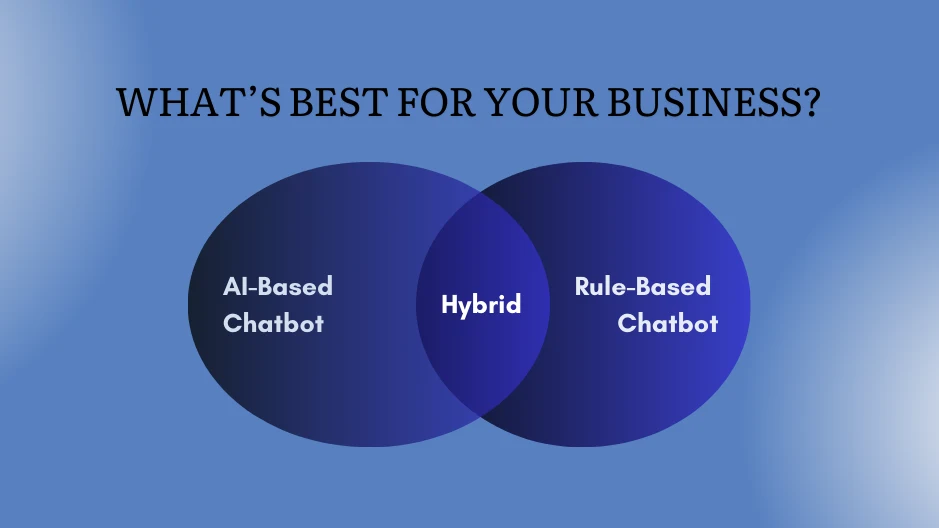
Scaling CX? AI is the Future
If your goal is to scale customer experience operations, invest in AI chatbot technology. AI chatbots offer:
- Real-time learning and personalization
- Multi-language support
- Higher CSAT and faster resolution times
These features lead to improved operational efficiency and greater customer loyalty.
Why Not Both?
In a war between AI-powered and Rule-based chatbots, Hybrid Wins. The smartest strategy is often to combine both chatbot types:
- Start with a rule-based layer to handle routine queries
- Use AI chatbots for handling complex scenarios or dynamic interactions
- Enable seamless handovers between the two for a smooth user journey
Not sure how to make your chatbot stand out? Explore The Ultimate Idea Bank
Robylon: The Best of Both Worlds
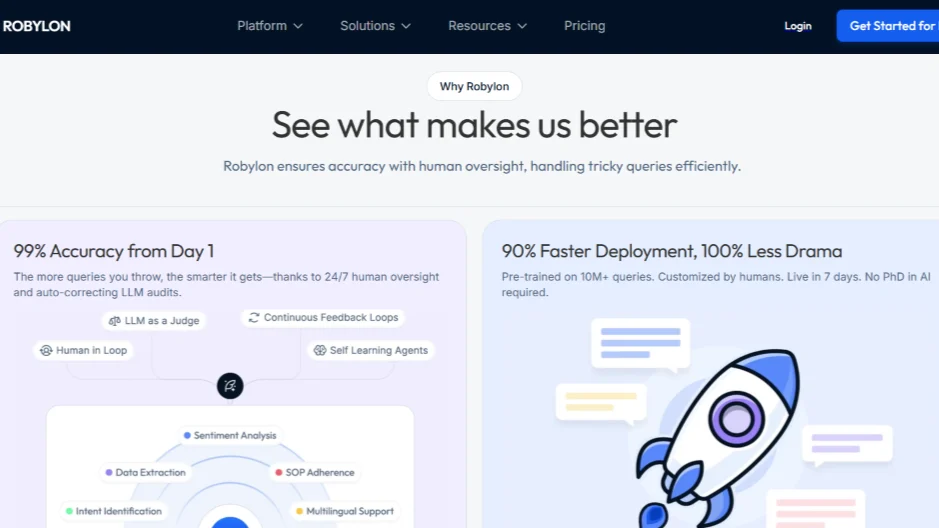
Robylon, help businesses deploy hybrid chatbot systems that blend rule-based reliability with AI flexibility. Whether you need a guided decision tree, a smart support agent, or a fully scalable AI assistant, the platform adapts to your unique business needs.
Book a demo today to explore how Robylon can elevate your support experience.
Conclusion
Choosing between a rule-based chatbot and an AI-powered chatbot depends entirely on your business objectives, user expectations, and the complexity of your support workflows. Looking for smarter ways to chat with your customers? Explore Robylon’s platform and see how AI chat can simplify support and sales.
Rule-based chatbots shine in structured, predictable scenarios where affordability and speed matter most. In contrast, AI chatbots offer unmatched adaptability, handling dynamic queries, multilingual interactions, and personalized experiences at scale.
If you are just starting out, a rule-based approach may suffice but for businesses aiming to future-proof customer support, an AI chatbot is the strategic investment. Ultimately, the most effective solution often lies in blending both, using rule-based logic for simple tasks and AI for high-impact interactions. By aligning your chatbot strategy with your growth goals, you ensure a support system that not only performs but evolves.
FAQs
What are common use cases for rule-based and AI-powered chatbots?
Rule-based bots are best for FAQs and booking flows. AI chatbots handle customer support, product recommendations, and intent-based conversations.
Are AI chatbots worth the higher cost for small businesses
If your use case is complex or multilingual, AI offers better long-term ROI. Otherwise, a rule-based chatbot can be a cost-effective entry point.
Can I use both rule-based and AI chatbots together?
Yes, hybrid chatbots combine rule-based reliability for simple tasks with AI for complex queries, offering a scalable and flexible customer support experience.
What are the pros and cons of AI chatbots vs rule-based chatbots?
AI chatbots offer adaptability and personalization, but need more setup. Rule-based bots are cheaper and faster but lack context or learning capabilities.
How do AI chatbots work compared to rule-based chatbots?
AI chatbots use natural language processing (NLP), intent recognition, and learning models. Rule-based chatbots use static flows based on buttons or keywords.
Which is better: an AI chatbot or a rule-based chatbot?
AI chatbots are better for complex, multilingual, and dynamic interactions. Rule-based bots are ideal for simple, structured tasks and fast deployment.
What is the difference between a rule-based chatbot and an AI chatbot?
A rule-based chatbot follows predefined scripts, while an AI chatbot uses NLP and machine learning to understand and respond dynamically to user queries.

.png)




